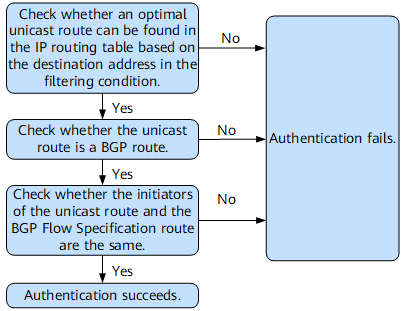Configuring Static BGP Flow Specification
BGP Flow Specification routes are generated manually to control traffic in static BGP Flow Specification.
Usage Scenario
When static BGP Flow Specification is configured, a BGP Flow Specification route needs to be generated manually, and a BGP Flow Specification peer relationship needs to be established between the device that generates the BGP Flow Specification route and each ingress on the network to advertise BGP Flow Specification routes.
In an AS with multiple ingresses, a BGP Flow route reflector (Flow RR) can be deployed to reduce the number of BGP Flow Specification peer relationships to be established and save network resources.
If you want to filter traffic matching a specified address prefix but BGP Flow Specification routes matching the specified address prefix fail to be authenticated, disable the authentication of the BGP Flow Specification routes received from a specified peer.
Procedure
- Create a BGP Flow Specification route manually.
- Configure BGP Flow Specification peer relationships.
BGP Flow Specification peer relationships must be established between the network ingress and device on which the BGP Flow Specification route is manually created.
- (Optional) Configure a Flow RR.
Before configuring a Flow RR, establish a BGP Flow Specification peer relationship between the Flow RR and the device on which the BGP Flow Specification route is generated and between the Flow RR and every network ingress.
- (Optional) Add the AS_Path attribute as a check item to BGP Flow Specification route verification rules.
- (Optional) Disable BGP Flow Specification route authentication.
- (Optional) Disable an EBGP peer from validating the received routes that carry a redirection extended community attribute.
- (Optional) Configure the device to recurse received routes with the redirection next-hop IPv6 address, color, and prefix SID attribute to tunnels.
- (Optional) Configure the redirection next-hop attribute ID for BGP Flow Specification routes.
The redirection next-hop attribute ID can be 0x010C (defined in a related RFC) or 0x0800 (defined in a related draft). If a Huawei device needs to communicate with a non-Huawei device that does not support the redirection next-hop attribute ID of 0x010C or 0x0800, set the redirection next-hop attribute ID of BGP Flow Specification routes as required. Perform one of the following configurations based on the ID supported by non-Huawei devices:
Set the redirection next-hop attribute ID to 0x010C (defined in a related RFC) for BGP Flow Specification routes.
- Run system-view
The system view is displayed.
- Run bgp as-number
The BGP view is displayed.
- Run ipv4-family flow
The BGP-Flow address family view is displayed.
- Run peer ipv4-address redirect ip rfc-compatible
The redirection next-hop attribute ID of the BGP Flow Specification route is set to 0x010C (defined in a related RFC).
- Run commit
The configuration is committed.
- Run system-view
Change the redirection next-hop attribute ID of BGP Flow Specification routes to 0x0800 (defined in a related draft).
- Run system-view
The system view is displayed.
- Run bgp as-number
The BGP view is displayed.
- Run ipv4-family flow
The BGP-Flow address family view is displayed.
- Run peer ipv4-address redirect ip draft-compatible
The redirection next-hop attribute ID of BGP Flow Specification routes is changed to 0x0800 (defined in a related draft).
- Run commit
The configuration is committed.
- Run system-view
- (Optional) Configure the interface in the BGP Flow Specification as the traffic-injection interface of the cleaned traffic to prevent the injected traffic from matching the Flow Specification rules and being switched back to the cleaning device.
- (Optional) Disable BGP Flow Specification on the interface.
- (Optional) Configure BGP Flow Specification for packets with a specified IP address sent to the public network.
- (Optional) Enable the CAR statistics and packet
loss statistics function for BGP Flow Specification.
- (Optional) Enable BGP FlowSpec for packets that have entered the VXLAN tunnel.
- (Optional) Enable BGP FlowSpec on a GRE tunnel interface.
- (Optional) Disable BGP FlowSpec protection.
- (Optional) Enable BGP Flow Specification IPv4 fragmentation rules to comply with RFC 5575.
Verifying the Configuration
After configuring static BGP Flow Specification, verify the configuration.
Run the display bgp flow peer [ [ ipv4-address ] verbose ] command to check information about BGP Flow Specification peers.
Run the display bgp flow routing-table command to check BGP Flow Specification routing information.
Run the display bgp flow routing-table [ peer ipv4-address ] [ advertised-routes | received-routes [ active ] ] statistics command to check BGP Flow Specification route statistics.
Run the display flowspec statistics reindex command to check statistics about IP packets matching a specific BGP Flow Specification route for BGP Flow Specification protocol protection on interfaces in a specified interface group.
- Run the display flowspec rule reindex-value slot slot-id command to check information about combined rules in the BGP FlowSpec local rule table.
- Run the display flowspec rule statistics slot slot-id command to check statistics about the rules for BGP FlowSpe routes to take effect.

